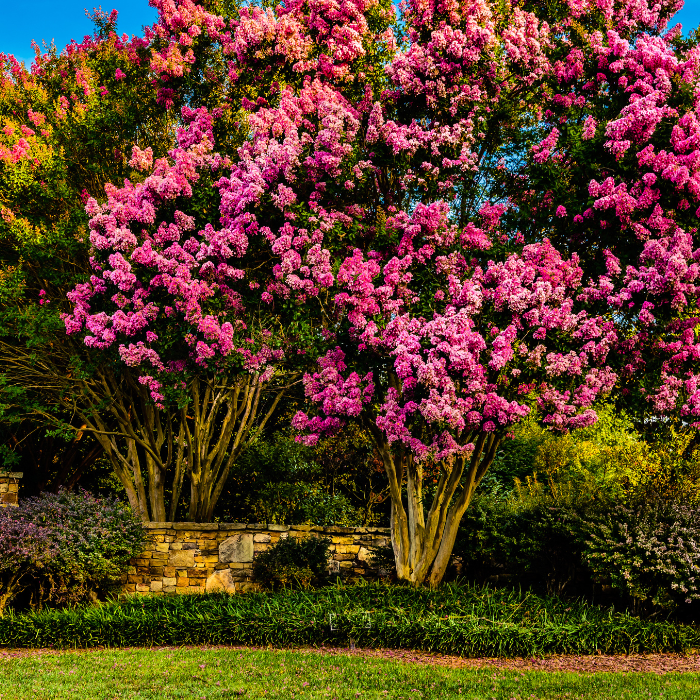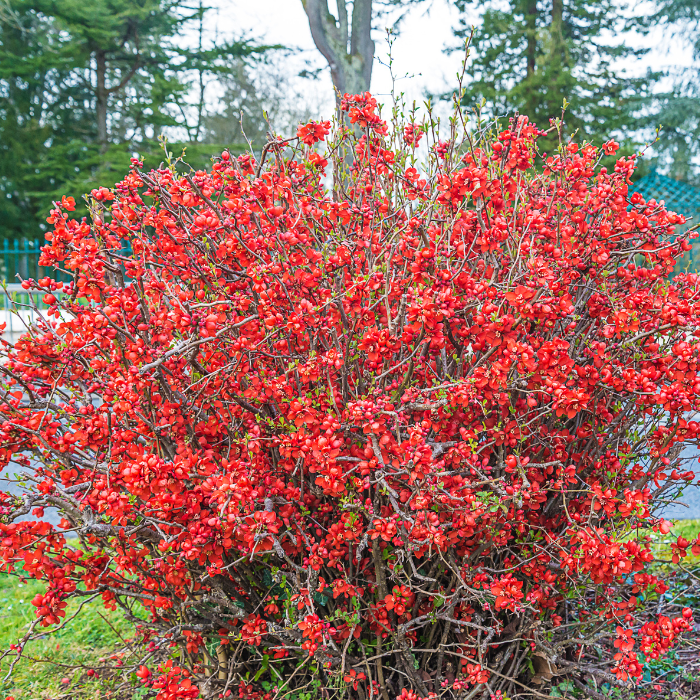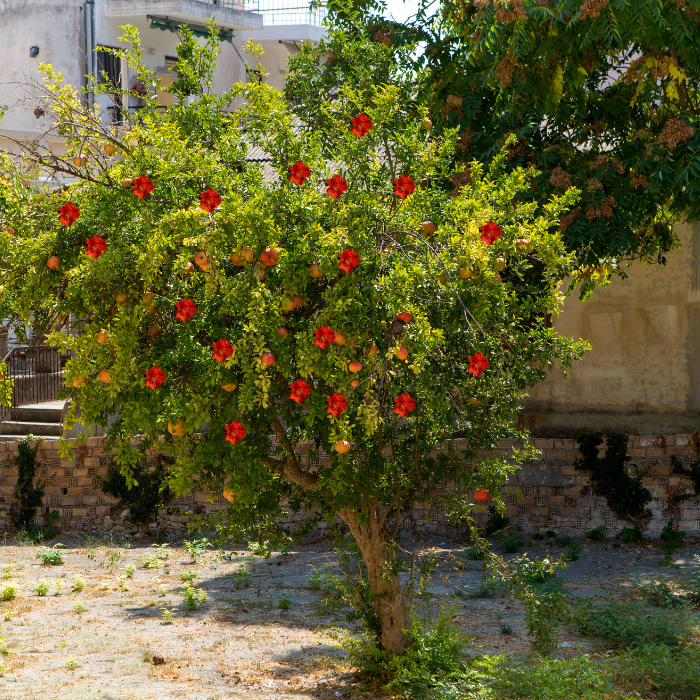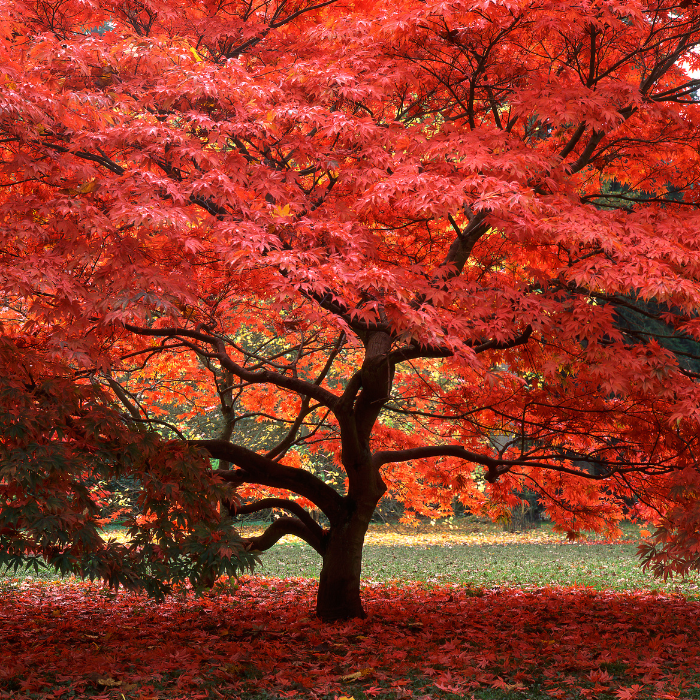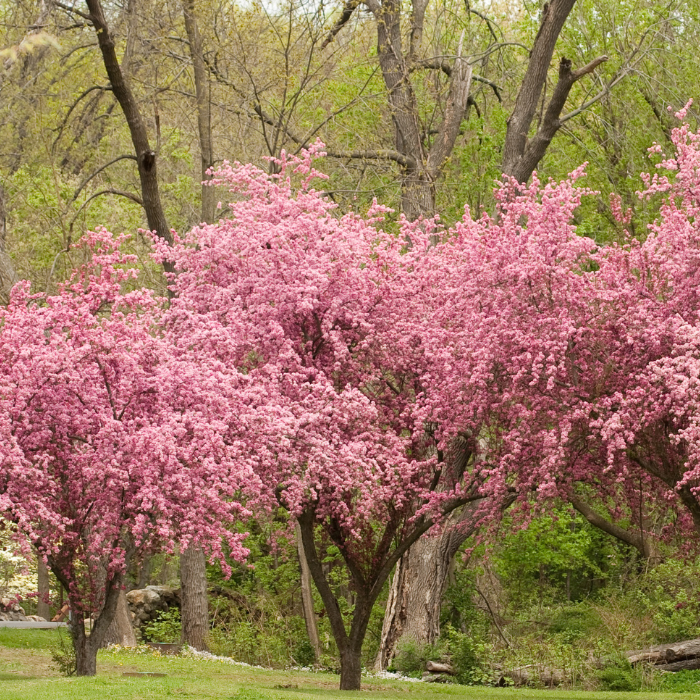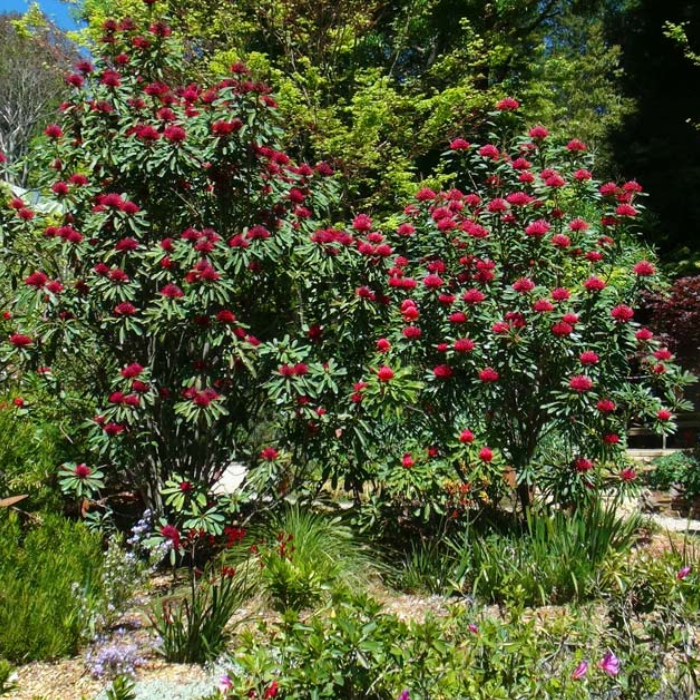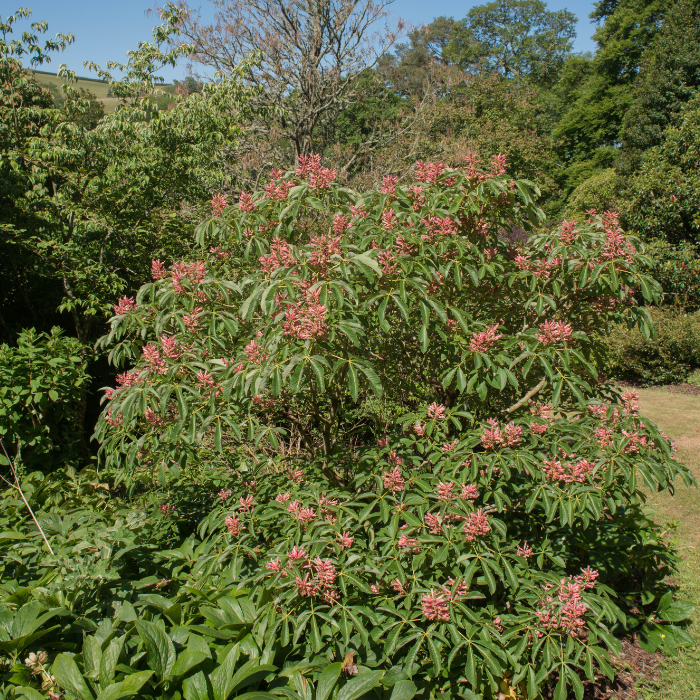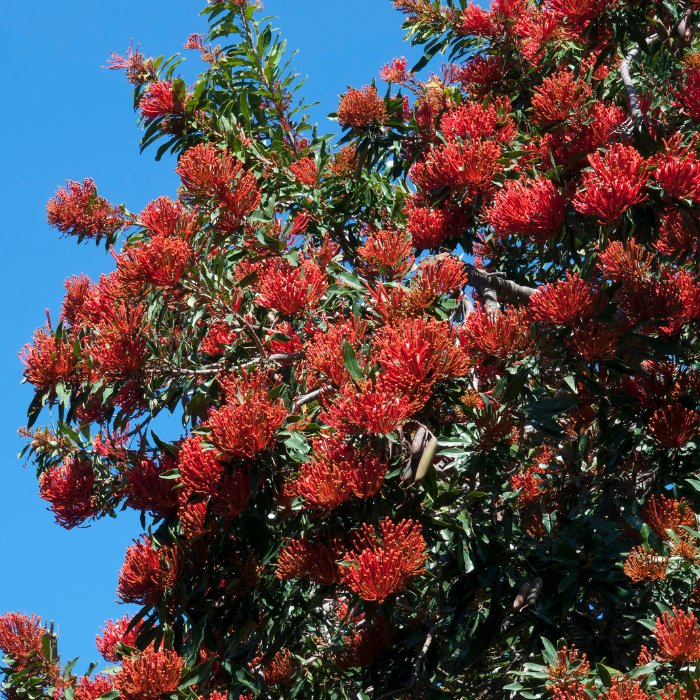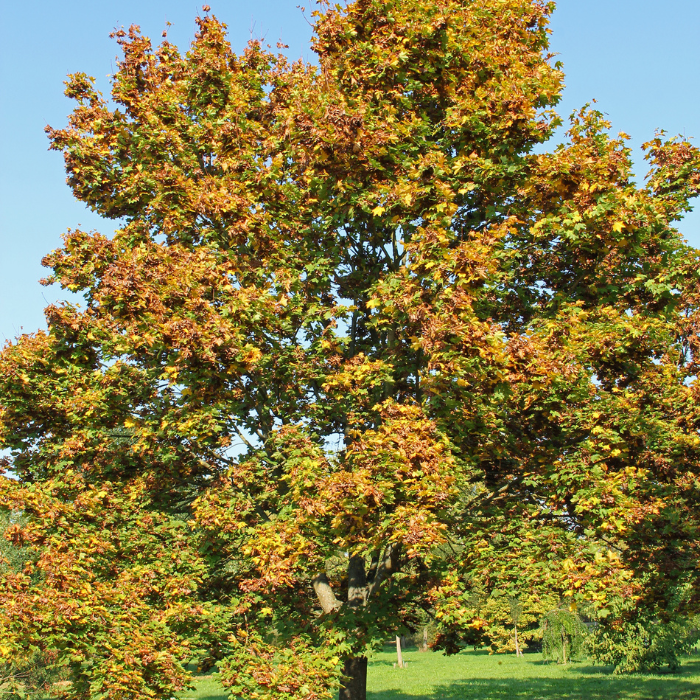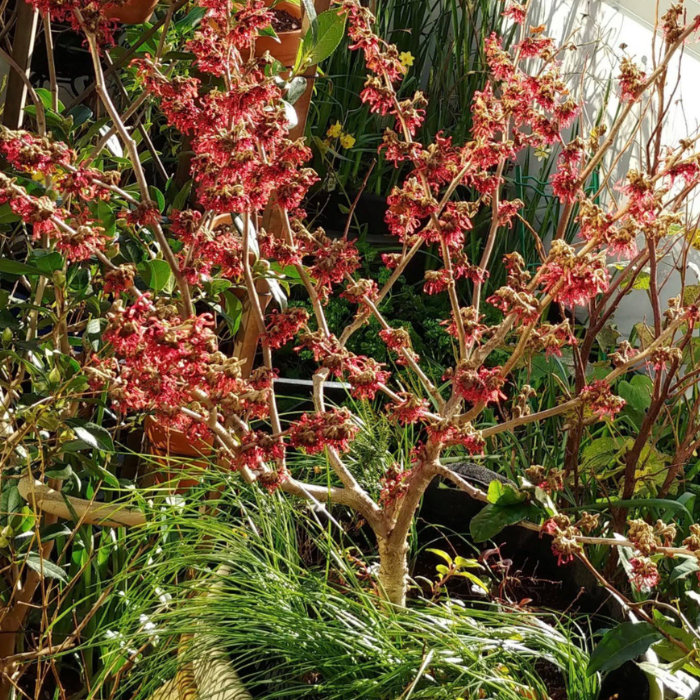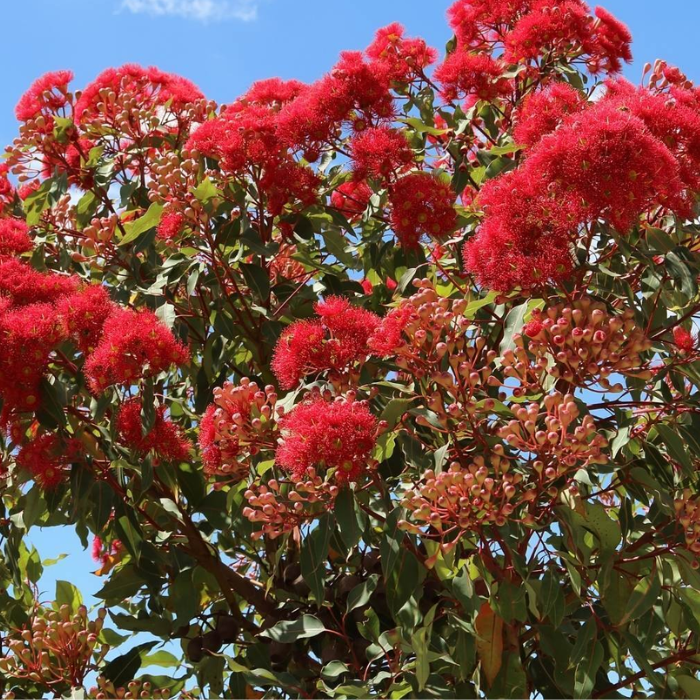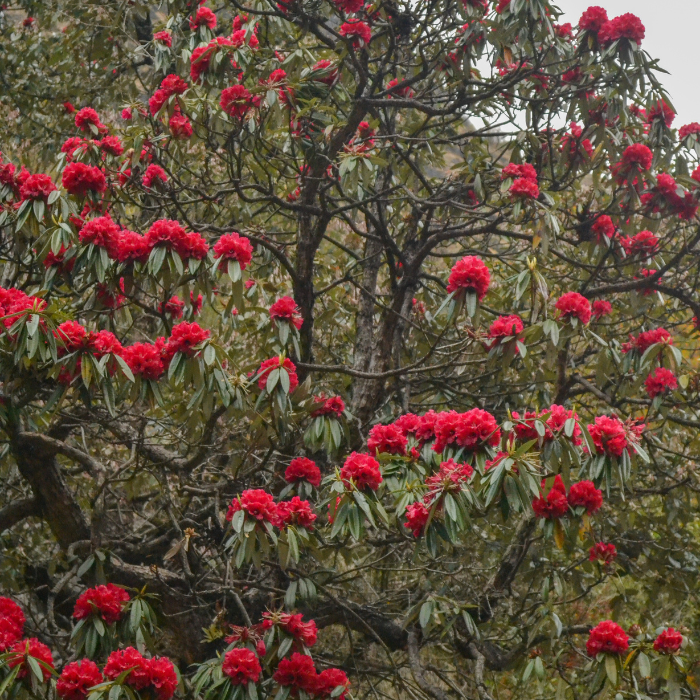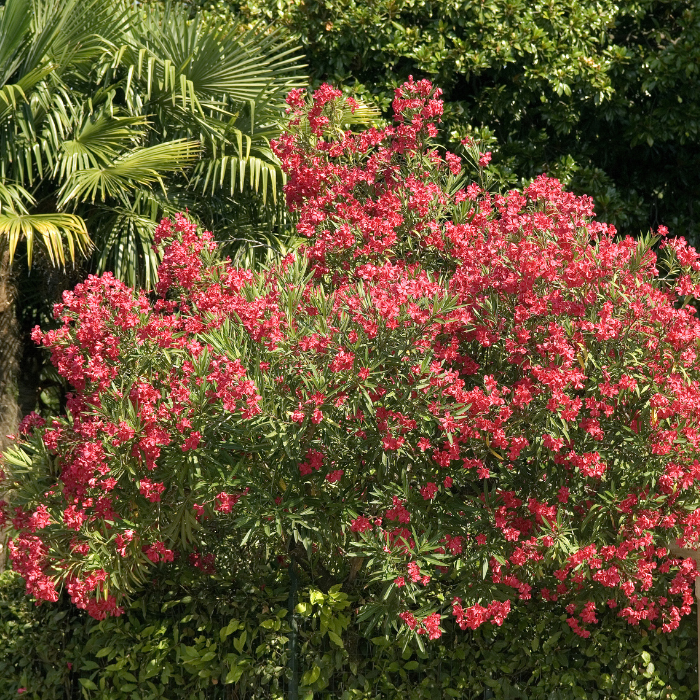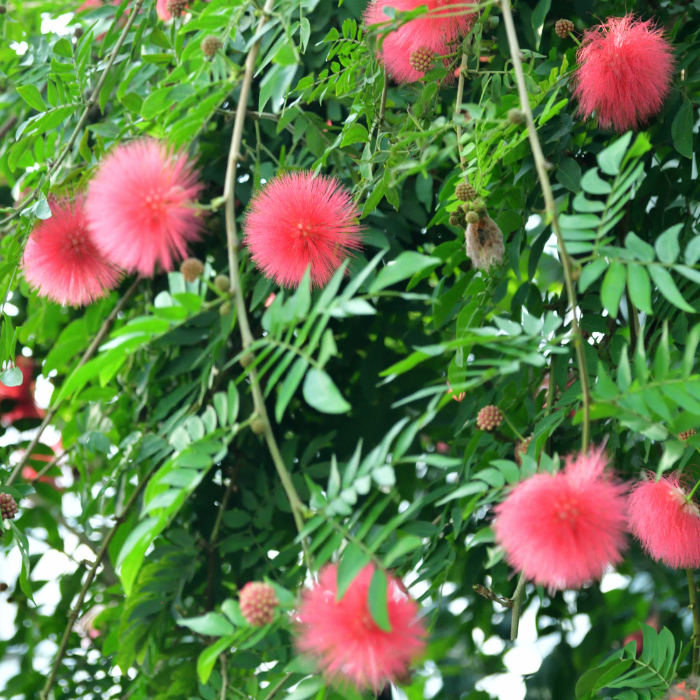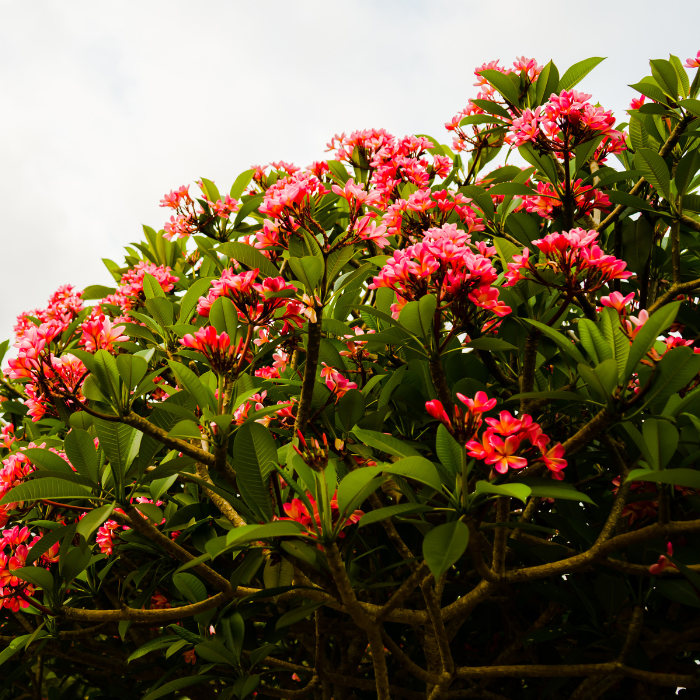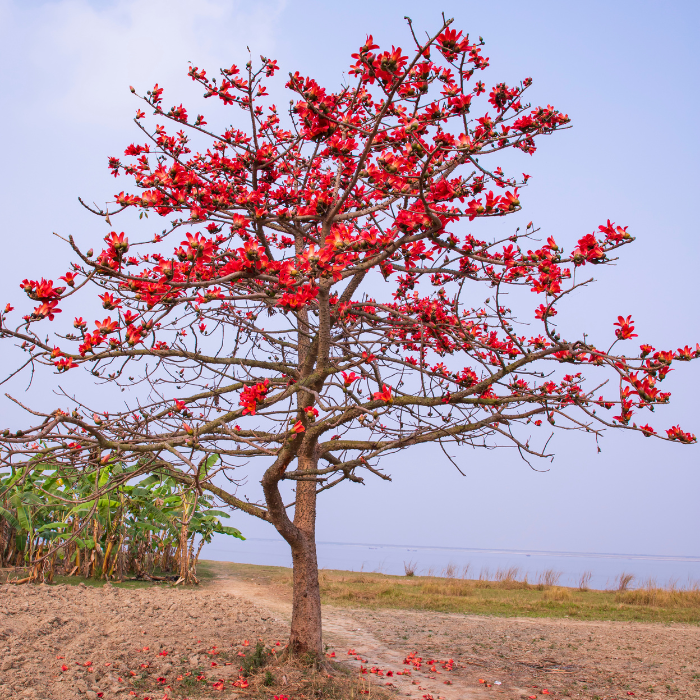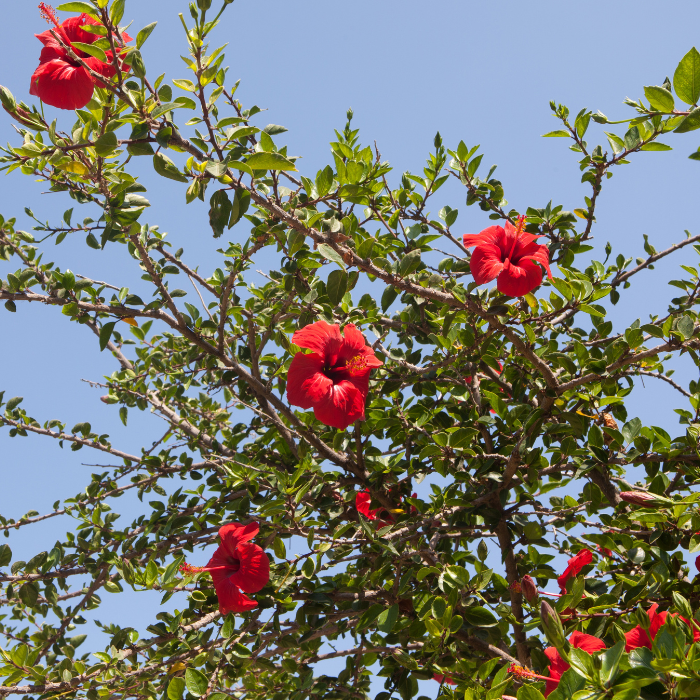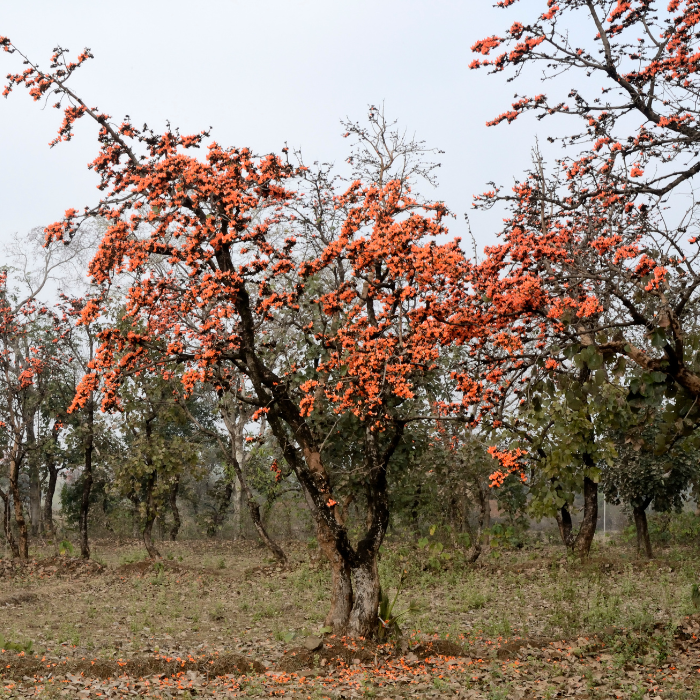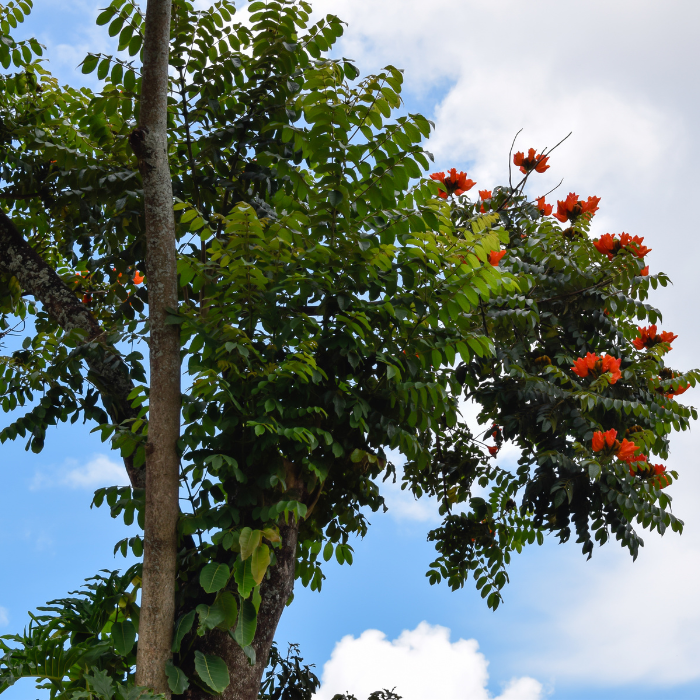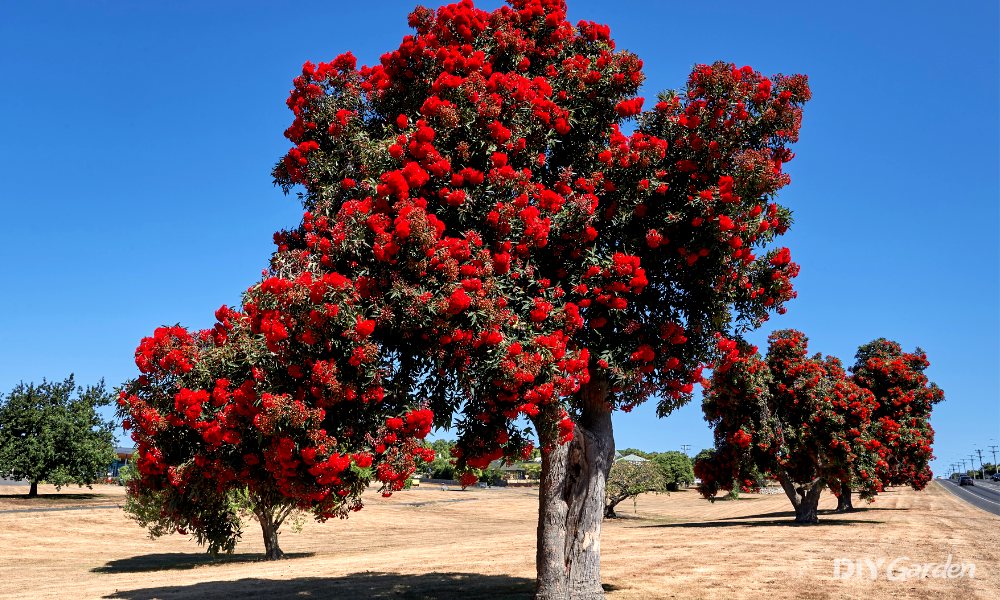
Gardens look a bit dull and dreary without any colour, particularly in the winter months. Luckily, it doesn’t take much to bring your garden back to life – just a pop of colour here and there.
If you’re looking to sprinkle some colour into your garden, red flowering trees are the way to go. They’re big, bold, and highly attractive to pollinators – you can’t get much better than that!
In this blog post, we’ll give you a whistle-stop tour of 25 of the best red flowering trees. Whether your garden gets full sun or is steeped in shade, is big or small, or you want plants that are low maintenance or needy, there’s a tree or two in this list for you.
Small Red Flowering Trees
1. Crepe Myrtle (Lagerstroemia)
Crepe Myrtle is a small bush or tree with big, showy flowers. Typically, Crepe Myrtles have pink, white, or purple flowers. But specific varieties, such as Lagerstroemia indica ‘Crimson Red Black Diamond’ and Lagerstroemia Red Rocket, are stunning red-flowering varieties. ‘Crimson Red Black Diamond’ blooms crimson-coloured flowers in late summer to early autumn, while Lagerstroemia Red Rocket sports cherry-red blossoms between mid and late summer.
Crepe Myrtle trees are renowned for their low maintenance requirements, drought tolerance, and hardiness to below-freezing temperatures. Due to this, they’re a popular choice for UK gardens.
2. Crab Apple (Malus sylvestris)
The Crab Apple, also known as the European Crab Apple, is a native tree that flourishes in our climate. It only reaches 10 metres in maturity, making it the perfect plant for a medium-sized garden or as a focal feature in a larger display.
The Crab Apple, an ancestor of cultivated apple trees, can often be found in hedgerows and on the edge of woodlands in the UK, but it’s also a very popular ornamental garden plant and a valuable natural screening plant.
If you’re looking to create your very own orchard, the Crab Apple makes the perfect accompaniment to cultivated apple trees, as it draws in bees and butterflies, ensuring you’ll have edible apples year after year.
READ NEXT: 50 Different Types of Fruit Trees
3. Japanese Quince (Chaenomeles japonica)
The Japanese Quince, also known as “Maule’s quince,” flowers in early spring, offering a valuable food source for bees when many plants are yet to flower. The flowers on the Japanese Quince are vibrant shades of orange and red and burst from the buds directly on the branches, giving the tree a big impact.
I love the Japanese Quince, not only for its beautiful blooms but also for its hardiness. It has minimal maintenance requirements, growing well in any soil type or amount of sunlight. You can even train it as a climber, growing up a trellis or wall.
4. Pomegranate Tree (Punica granatum)
You may not have grown this tree before, but you’ll definitely be familiar with its fruit. Pomegranate Trees produce – you guessed it – pomegranates! A fruit that’s widely available in supermarkets in the UK. However, despite its availability as a fruit, it’s not commonly grown as a garden plant in the UK, as it requires long, hot summers to grow well and above 13ºC temperatures in autumn to produce fruit.
Regardless of this, the Pomegranate Tree is still a great addition to a garden and can be grown if you place it in a warm, sheltered spot facing west or south.
5. Japanese Maple (Acer Palmatum ‘Atropurpureum’)
Japanese Maple is a woody shrub or small tree that’s endemic to areas of Asia and Russia, so it’s the perfect tree to add some oriental zen to your garden. It’s a slow-grower and only reaches 8 metres in full maturity, so it’ll suit a small or medium-sized garden well.
Unfortunately, Japanese Maples tend to be pretty expensive in the UK market. However, you can occasionally find them being sold in supermarkets like Tesco and Asda. I got mine from Asda, and with a little love, it has done quite well!
READ NEXT: 28 Zen Japanese Garden Ideas UK (Modern & Budget-Friendly)
6. Prairie Crabapple (Malus Prairifire)
The Prairie Crabapple is a deciduous tree that keeps us interested right through the seasons, with pinky-red buds turning into red flowers in mid to late spring that cloak the tree’s branches. When the flowers finish their blooming season, they’re replaced by purply-red fruit that stick around for several months. And if that weren’t enough, the leaves also turn from maroon to verdant green with purple veins to golden throughout the seasons!
7. New South Wales Waratah (Telopea Speciosissima)
The New South Wales Waratah, also often called simply “Waratah,” is a large shrub or small tree that grows to around 4 metres tall and 2 metres wide. Its trunk swells at the base, producing a “lignotuber” – some trees have these as a form of protection from destruction through fire or to help them survive harsh conditions.
Locally and worldwide, the New South Wales Waratah is appreciated for its striking red flowerheads, each containing 100s of minute flowers.
8. Red Buckeye (Aesculus pavia)
This tree goes by two names – Red Buckeye and Firecracker Plant. Whatever you call it, it’s a small flowering tree with a lot of gusto. It’s originally from the southern and eastern US but has now been widely cultivated all the way to Finland.
If you’re choosing Red Buckeye for your garden, it’s important to pick the right one. While Aesculus pavia var. pavia is the typical red buckeye with red flowers, Aesculus pavia var. flavescens produces yellow flowers – you wouldn’t want to get those mixed up!
Tall Red Flowering Trees
9. Red Silky Oak (Alloxylon flammeum)
Red Silky Oak is a large flowering tree from the rainforests of North Queensland. The way this plant’s flower spikes point upwards makes them look like a flame, creating quite a captivating display when they emerge in spring.
Due to its hardiness and adaptability, this tree can handle various soil types and growing conditions, so it’ll survive just fine in the UK.
10. Indian Coral Tree (Erythrina Variegata)
The Indian Coral Tree is known and loved for its crimson flowers that stick out like fiery stars from its branches. This is a tall tree that grows up to 27 metres tall and is highly valued as an ornamental tree in many areas of the world. In Vietnam, the Indian Coral Tree’s large leaves are used for wrapping fermented meat, and its bark and leaves are used in alternative medicines in the Philippines.
11. Norway Maple ‘Crimson King’ (Acer Platanoides ‘Crimson King’)
The Norway Maple ‘Crimson King’ gets its name from its year-round colour, showing off copper orange-red flowers in spring and deep, moody-looking purple foliage from spring to autumn. This tree grows to between 8 and 12 metres tall over its 20 – 50 year lifespan, and favours full sun or partial shade.
12. Witch Hazel ‘Diane’ (Hamamelis x intermedia ‘Diane’)
Witch Hazel ‘Diane’, like all Witch Hazels, has distinctive flowers with downward-curling petals. However, this one stands out from the rest due to its flowers’ deep red-purple colouration. The blooms appear in winter, bringing a splash of colour to an often dreary season.
This tree grows up to 12 metres tall, making it a fairly tall tree, ideal for a medium garden or a focal feature in a larger garden.
READ NEXT: Witch Hazel Care Guide: How to Grow Hamamelis
13. Red Horse Chestnut (Aesculus × carnea)
Red Horse Chestnut is an artificial hybrid produced by crossing Red Buckeye (the very one we spoke about earlier) and the Horse Chestnut tree. While it’s not certain where this tree originated, one thing is for certain – we love this medium-large tree in the UK, particularly in gardens and parks. This tree produces flower stalks that stick out from the stems and reveal pinky-red, showy flowers that we Brits can’t get enough of.
Evergreen Red Flowering Trees
14. Crimson Bottlebrush (Callistemon citrinus ‘Splendens’)
The Crimson Bottlebrush is unlike any other tree on this list. Why? Simply due to its flower formation. This evergreen shrub or small tree has highly distinctive flower spikes in a striking crimson-red colour. These reveal themselves as an array of needles protruding from the plant’s branches.
But this isn’t the only reason for its popularity. The Crimson Bottlebrush is also a really reliable grower outdoors, not only thriving in the UK climate but providing year-round interest, as it doesn’t lose its leaves come autumn.
15. Red Flowering Gum (Corymbia ficifolia)
Similar to the Crimson Bottlebrush, the Red Flowering Gum sports flower spikes rather than the normal flower petals we tend to see. However, these appear in circular clusters, not a bottlebrush shape.
The Red Flowering Gum tends to flower sporadically across the year, so you’ll never quite know when the unique blooms are about to appear. This makes it a wonderful addition to any garden, particularly if you want to add an unusual, surprising element.
This evergreen tree prefers full sun, but it’ll also manage well in a lightly shaded spot. It requires well-drained soil, but it doesn’t matter if it’s moist or a little dry. It’s salt – as well as drought-tolerant, making it the top choice if you have a coastal garden.
16. Tree Rhododendron (Rhododendron arboreum)
Tree Rhododendrons take all the qualities we love in shrub rhododendrons and add height. In fact, this species holds the Guinness Record for the World’s Largest Rhododendron. These trees don’t typically grow more than 12 metres tall – however, if you take special care and nurture it, it can reach heights of 20 metres.
This is another plant that offers year-round interest – it’s an evergreen tree, keeping its leaves throughout the year, then providing a pop of colour in early to mid-spring, when its red flowers appear. The pinky-red petals are peppered with black spots, and inside, you’ll find black nectar pouches, which pollinators simply love!
READ NEXT: Rhododendron Care Guide: How to Grow This Spring-Flowering Shrub
17. Royal Poinciana (Delonix Regia)
Royal Poinciana is a flamboyant tree that produces clusters of orange-red flowers in summer and sports verdant, fern-like leaves year-round. But beware, if exposed to drought, this tree will drop its leaves. But that’s not something we typically have to worry about here, is it?
The Royal Poinciana is endemic to the dry forests of Madagascar but is now also widely grown in tropical regions across the world.
18. Weeping Bottlebrush (Melaleuca viminalis)
The Weeping Bottlebrush has a descriptive name, and for good reason – this small tree’s vibrant, red flowers take the form of a bottlebrush lookalike and hang downwards toward the ground, hanging from weeping branches. These blooms appear in spring and summer and secure their popularity as an ornamental plant in gardens and on streets across many countries of the world.
19. Oleander (Nerium oleander)
Oleander is a fast-growing shrub or small tree that thrives in the warmer climates of subtropical regions. It boasts beautiful, star-shaped flowers in a dark fuschia-pink to red shade almost throughout the entire year in these regions. It also keeps its leaves throughout the year, making it exciting to look at, whatever the time of year.
Unfortunately, it’s not all peaches and cream with Oleander. This plant is extremely toxic, causing stomach problems and even heart problems if it’s ingested. It’s best to keep this one away if you have children or pets!
20. Red Powder Puff (Calliandra Haematocephala)
If you’re familiar with a powder puff, then you’ll be able to visualise exactly what this tree’s blooms look like. Now, envision them as a glorious shade of dark crimson, and you’ll have it spot on. This shrub or small tree grows quickly and tends to spread wide, too, but if you want it smaller, this tree can handle a good harsh pruning.
The Red Powder Puff is a favourite among butterflies and hummingbirds, but only from November until April.
Tropical Trees with Red Flowers
21. Red Frangipani (Plumeria rubra)
The Red Frangipani tree has a playful appearance to suit its name. This shrub or small tree has glorious, umbrella-shaped branches with intensely scented pinky-red flowers that boast an interesting spiral shape. This is a tropical plant that tends to bloom year-round in its native habitat, but unfortunately, it won’t perform as well in colder climates.
Nevertheless, Red Frangipani is an excellent choice for a specimen or patio tree, and it works well in a mixed shrub border, as its height (up to 8 metres in the UK) brings vertical interest.
22. Red Silk Cotton Tree (Bombax ceiba)
In Cantonese, the scientific name “Bombax ceiba” literally translates to “cotton-tree flowers.” Why? Well, the Red Silk Cotton Tree produces capsules which contain white fluffy fibres that are very similar to cotton when ripe. These fibres have played a pivotal role in textile production in Nepal and India.
This tree’s trunk is adorned with spikes to prevent animals from climbing up it and stealing its precious fruit. Unfortunately though, it doesn’t have the same sort of protection against frost, meaning it’ll need to be kept in a greenhouse or conservatory during the UK’s cold winters.
23. Shoeblackplant (Hibiscus Rosa-Sinensis)
Shoeblackplant is a tropical hibiscus tree native to China and grown widely in the tropical and subtropical areas of the world. This tree is far from hardy in the UK climate, so you’ll need to give it some TLC to keep it alive. Grow it in a pot indoors, and it’ll reach around 2 metres tall, giving you a fabulous ornamental houseplant.
24. Flame of the Forest (Butea monosperma)
Flame of the Forest truly is an apt name for this tree. This tree is an early flowerer, producing an abundance of fiery red-orange flowers from late winter until early spring. This tree is a thoroughly appreciated ornamental plant (especially in Mediterranean gardens) across the globe, but it’s more than that for Hindus, who worship this tree as sacred.
25. African Tulip Tree (Spathodea campanulata)
The African Tulip Tree is a highly ornamental species grown throughout the tropics as a specimen tree and focal feature. Its most outstanding feature is its vibrant red-orange or crimson flowers that form a tulip-like shape, hence the name.
Unfortunately, this tree has a bad track record. On the Global Invasive Species Database, this tree is listed as the 88th worst invasive species.
Trees With Red Flowers FAQs
What is a tree with red flowers called?
Rhododendrons are often associated with shrubs. However, Rhododendron trees, also known as “Tree Rhododendrons,” are small trees prized for their vibrant red blooms. These are a popular choice in UK gardens because they add elegance and colour. Tree Rhododendrons are known for their ability to thrive in acidic soil conditions, making them particularly well-suited to UK gardens.
What is the red flowering tree in Spain?
The red flowering tree commonly seen in Spain is the Royal Poinciana. Despite this tree originating on the island of Madagascar, it’s often associated with Spain as it has been planted there in abundance as an ornamental tree. It grows up to 12 metres tall and has stunning red flowers and fern-like foliage.
Green pairs perfectly with red, so why not mix some luscious green plants in with your new red flowering trees? If this takes your fancy, you’ll love our post, 12 Fast Growing Evergreen Trees.
